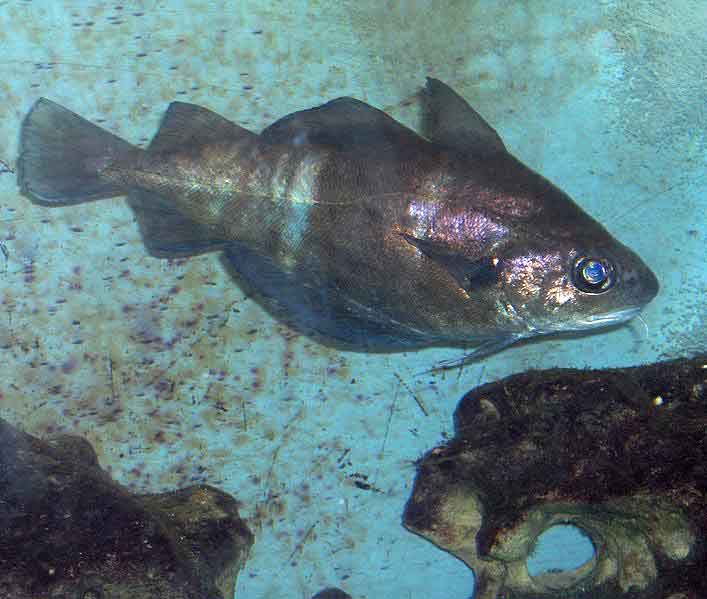
Trisopterus luscus (*)
Superregnum : Eukaryota
Cladus: Unikonta
Cladus: Opisthokonta
Cladus: Holozoa
Regnum: Animalia
Subregnum: Eumetazoa
Cladus: Bilateria
Cladus: Nephrozoa
Superphylum: Deuterostomia
Phylum: Chordata
Subphylum: Vertebrata
Infraphylum: Gnathostomata
Megaclassis: Osteichthyes
Superclassis/Classis: Actinopterygii
Classis/Subclassis: Actinopteri
Subclassis/Infraclassis: Neopterygii
Infraclassis: Teleostei
Megacohors: Osteoglossocephalai
Supercohors: Clupeocephala
Cohors: Euteleosteomorpha
Subcohors: Neoteleostei
Infracohors: Eurypterygia
Sectio: Ctenosquamata
Subsectio: Acanthomorphata
Divisio/Superordo: Paracanthopterygii
Series: Zeiogadaria
Subseries: Gadariae
Ordo: Gadiformes
Familia: Gadidae
Subfamilia: Gadinae
Genus: Trisopterus
Species: Trisopterus luscus
Name
Trisopterus luscus (Linnaeus, 1758)
Original combination: Gadus luscus
Synonyms
Gadus barbatus Linnaeus, 1758
References
Linnaeus, C. 1758. Systema Naturae per regna tria naturæ, secundum classes, ordines, genera, species, cum characteribus, differentiis, synonymis, locis, Tomus I. Editio decima, reformata. Holmiæ: impensis direct. Laurentii Salvii. i–ii, 1–824 pp DOI: 10.5962/bhl.title.542: 252. Reference page.
Trisopterus luscus – Taxon details on Integrated Taxonomic Information System (ITIS).
Trisopterus luscus in the World Register of Marine Species
Vernacular names
brezhoneg: Moulleg
català: Mòllera fosca
Deutsch: Franzosendorsch
English: Pouting
español: Faneca
euskara: Paneka handi
suomi: Partaturska
français: Tacaud commun
galego: Faneca
magyar: Francia tőkehal
italiano: Merluzzetto bruno
Mirandés: Faneca
Nederlands: Steenbolk
norsk: Skjeggtorsk
polski: Bielmik
português: Faneca
slovenščina: Francoski molič
svenska: Skäggtorsk
中文: 條長臀鱈
Trisopterus luscus (Latin pronunciation: [ˈtrisopterus ˈluskus]; bib, pout whiting, pout or most commonly pouting) is a seafish belonging to the cod family (Gadidae).
Distribution, size and life cycle
Pouting are found predominantly in European waters, especially around the south and west of the British Isles and in Scandinavian waters, although they can also be found in the Mediterranean and along the north African coast.[2] They can be found across rocky and sandy seabeds with smaller specimens being found close to the shore and larger pouting being moving further offshore. The greatest depths at which pouting can be found is 300 metres.[3] Pouting are generally a small fish, seldom exceeding 30 centimetres in length, although rare specimens can reach almost double this length. Pouting can reproduce before they reach two years of age and grow rapidly, reaching around 15 centimetres in length by the end of their first year. Pouting are a relatively short lived species, with the average lifespan thought to be around four years.[4]
Feeding and diet
Pouting are scavengers which feed on the seabed. They forage for any food source they can find with marine worms, shellfish and dead fish all making up their diet.[4] Due to their small size pouting are a source of prey for large species such as cod, bass and conger eels.
Commercial value
Pouting were previously ignored as a commercial fish, with pouting that were inadvertently caught by trawlers being either discarded at sea or processed into fishmeal.[4] Captured pouting are unlikely to survive when discarded.[5] However, the decline in the stocks of whitefish species such as cod and haddock has seen pouting acquire a growing value as a commercial fish,[4] and they are now available both as whole fish from fishmongers and supermarkets and are also used in fish products such as fish fingers and ready meals. Due to their naturally short lifespan and early breeding age pouting are seen as a relatively sustainable fish to eat.[6]
References
Di Natale, A.; Molinari, A.; Őztűrk, B. & Srour, A. (2011). "Trisopterus luscus". IUCN Red List of Threatened Species. 2011: e.T198587A9042469.
"Trisopterus luscus". FishBase. Retrieved 5 January 2017.
"Bib or Pouting, Trisopterus luscus". MarLIN - The Marine Life Information Network. Retrieved 5 January 2017.
"Pouting". British Sea Fishing. Retrieved 5 January 2017.
Depestele, J.; Desender, M.; Benoît, H. P.; Polet, H.; Vincx, M. (2014). "Short-term survival of discarded target fish and non-target invertebrate species in the "eurocutter" beam trawl fishery of the southern North Sea". Fisheries Research. 154: 82–92. doi:10.1016/j.fishres.2014.01.018.
"Pouting or Bib". Good Fish Guide. Marine Conservation Society. Archived from the original on 14 July 2014. Retrieved 1 July 2014.
Retrieved from "http://en.wikipedia.org/"
All text is available under the terms of the GNU Free Documentation License

